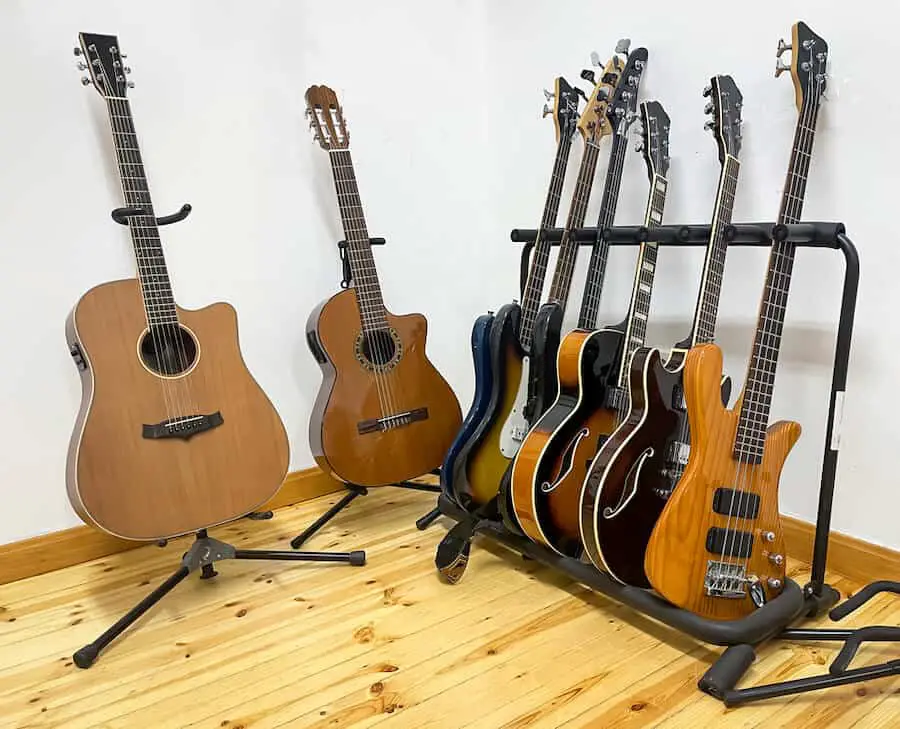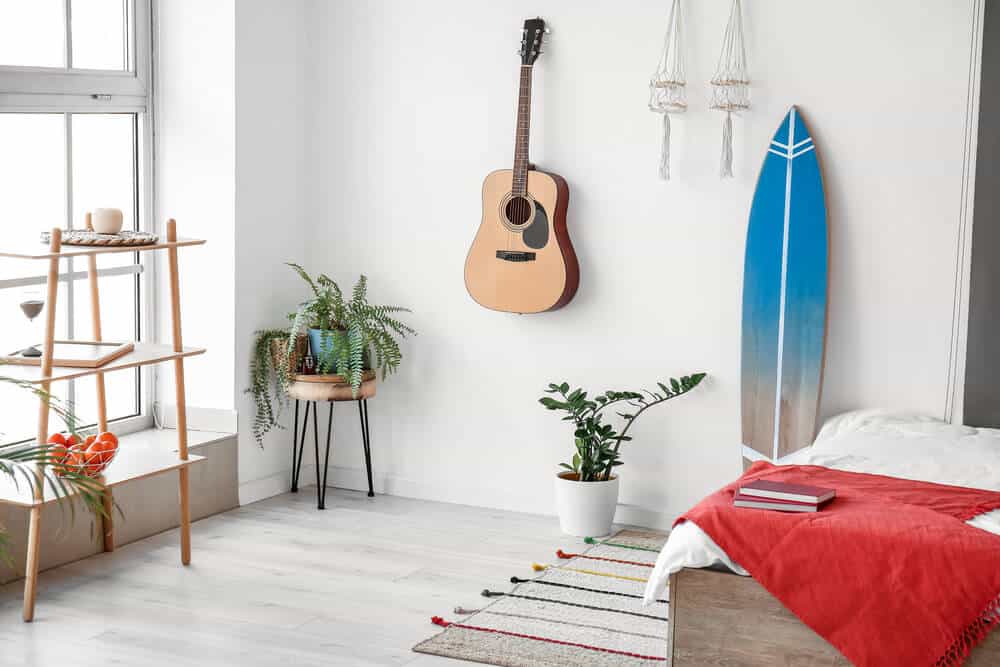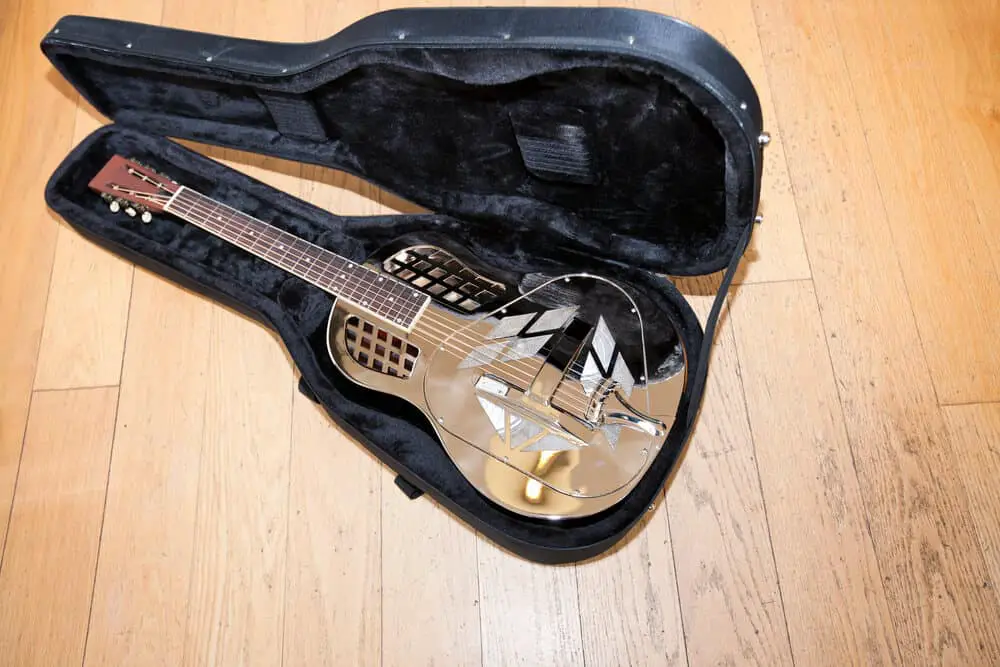Some rock stars smash their guitars after every show…but that’s probably too expensive for most of us, who prefer to lovingly care for and store our instruments when not in use. But what’s the best way to do that?
To properly store your guitar, you should keep it within the ideal temperature (roughly 70 degrees Fahrenheit) and humidity (40-50%) ranges and avoid prolonged direct sunlight exposure. Guitar stands and wall hooks are perfectly safe storage options, but a case is even safer, as long as it’s stored standing up.
Let’s break down in more detail the best way to store your guitar to keep it out of harm’s way.
How to Store a Guitar (The Ideal Conditions)

1. Keep Temperature Around 70 Degrees Fahrenheit
Ambient temperature is the first thing to consider. Ideally you want to store your guitar in a location where you can regulate the temperature at roughly 70 degrees Fahrenheit / 21 degrees Celsius.
A guitar is primarily made of wood which, depending on the species, can be relatively sensitive to very hot or very cold conditions. While this doesn’t mean you need to worry about your guitar exploding if the temperature moves slightly above or below this ideal range, the wood will be happiest (and the least stressed) around 70 degrees Fahrenheit.
When it comes to temperature, the most concerning occurrence is a drastic temperature swing. Wood has a tendency to expand in warm temperatures and contract in cold temperatures. If it’s allowed to do so gradually, there isn’t an issue…but a guitar moving rapidly from extreme cold to extreme heat (or vice versa) is at risk of damage.
2. Regulate Humidity to 40-50%

Your guitar can handle some relatively cold and hot temperatures without suffering irreparable damage, but moisture is another story.
Though a guitar is sealed with a top coat to protect its finish from wear, this does little to protect it from moisture…and does nothing to protect the electronics if you have an electric guitar. Very humid environments can cause a guitar to swell, damaging its wooden layers and the joint holding the neck to the body. A guitar’s electronics are also at risk of rusting or shorting out.
For a more detailed look at this, see our article on protecting your guitar from moisture.
While excessively humid conditions are to be avoided, so too are extremely dry conditions. Under these conditions, your guitar will dry out. The wood will contract and shrink away, especially at the joints. If left in this state for long enough, your guitar will become brittle and at greater risk of damage.
The ideal humidity range for storage is between 40-50%. This is adequate for keeping your guitar from drying out while ensuring it doesn’t absorb too much moisture.
You can even buy specialized guitar humidifiers if you want to maintain a precise humidity to maintain your instrument.
3. Avoid Direct Sun Exposure
If you store your guitar in full view of a sunny window, chances are that over time you’ve noticed the finish isn’t as bright and glossy as it used to be. Just how most anything left out in the sun will fade, so too will your guitar’s finish. It’s pretty challenging to restore once it’s gone.
It’s best to keep your guitar out of direct sunlight to protect its luster. If your music room just happens to be in a very sunny spot, it would be best to store your guitar in its case to keep it away from the sun’s harmful rays.
4. Store Standing Up

Whether you choose to use a guitar stand, a wall hook or a case, always store your guitar standing up.
First and foremost, storing your guitar in an upright position makes it more visible so it’s less likely to get accidentally trampled on by you, your family members or your pets.
It also protects the strings and tuning pegs. If you lay your guitar down with the headstock touching the ground, it’s possible the tuning pegs can rotate or get bent if the guitar gets jostled around. This also puts pressure on the headstock, which on many guitars is set at an angle, making it prone to damage in this position.
Storing your guitar upright makes it more visible, more accessible, and less at risk of an unfortunate mishap.
How to Store a Guitar in a Small Room

If space is at a premium and you have one or more guitars to store, here are some tips.
First, it may actually be easier and more efficient to store your guitar in a small space. A room with less square footage will be easier to keep at a constant, regulated temperature and humidity, so you can worry less about fluctuations.
If this small space isn’t just a storage closet but where you practice as well, consider storing your guitar on a wall hook. That way you can keep it off the floor to maximize usable space. Hang it right above your amp to keep things tidy.
If you have multiple guitars to store, wall hooks are a valid option, but so is a multi-guitar stand. These stands are low profile, taking up much less space than an equivalent number of single-guitar stands. They’ll hold your guitars upright in an orderly line, keeping them safe and out of the way when you’re not playing.
How to Store a Guitar Long Term

If you’ve bought too many guitars for the space you have and are now forced to relocate some to a different location, you’re not alone. It’s a common habit among guitarists: when we’re not actively buying a new instrument, we’re researching what we want to buy next. So how do you store your guitar long-term so it’s ready to rock once you put it back in circulation?
The best storage option is in a hard case. Stands and wall hooks are better for displaying guitars you use regularly, but a case offers superior protection for those you won’t be playing for a while. Not only does a case protect a guitar from physical damage, but it also keeps it free from dust and debris and protects it from sunlight exposure.
Store your guitar standing up if possible, or at least on its side. Avoid storing it on its back, and if you have multiple guitars, never stack them on top of each other.
If your guitar will be riding out seasonal changes, it’s a good idea to invest in a guitar case humidifier. We know that guitars can handle changes in temperature (as long as they’re gradual), but aren’t as resistant to changes in humidity. A case humidifier helps regulate conditions inside the case when the humidity outside the case is less than optimal.
Check out our article on storing guitars in cold weather for some examples of guitar case humidifiers.
Before you pack your guitar in its case, tune the strings down at least a half step. This reduces string tension, thereby reducing tension on the neck and headstock of your guitar. No need to have all that extra tension stretching out your strings or placing unnecessary stress on your guitar when it’s not being used anyway.
If your guitar has a Floyd Rose bridge, remove the tremolo arm. If your case is pretty low profile, you don’t want the lid pushing down on the tremolo arm and placing stress on the bridge for an extended period of time.
Follow these steps and your guitar should be safe and ready to go when you call it back into action.
Stand vs. Hanger vs. Case (Best Tool for Guitar Storage)
Should You Store Your Guitar on a Stand?
A guitar stand is probably the most common method used to display a guitar at home or in the studio. Stands are inexpensive and make your guitar easily accessible. While they are a popular option, there are a few things to consider.
First, though stands can be cheap, it’s worth investing in one that’s constructed well. A good stand should have a wide base for added stability. You’re going to regret saving a few bucks on the cheaper stand when it topples over, sending your guitar crashing to the floor.
Second, a stand will typically have a soft material covering the spots where the guitar contacts the stand, usually a foam or hard rubber. Foam is better: while rubber will still protect your guitar from getting dinged, it tends to leave scuff marks or wear your guitar’s finish slightly. Place a cloth over these contact points and rest your guitar on it for added protection.
Third, a stand may not work for all guitar shapes. A stand is designed to cradle the convex base most guitars have. However, if your guitar has a more unique shape (like a Gibson Flying V or Explorer or a B.C. Rich Warlock), it simply won’t sit in a stand.
Finally, you should consider your environment. A good stand will support and protect your guitar, but it doesn’t provide much elevation. If you’ve got children or pets running around your home “studio,” it’s much easier for them to inadvertently knock over a guitar in a stand compared to the other storage solutions we’ll discuss next.
Should You Hang Your Guitar?
Displaying your guitar on a wall hook has some obvious advantages as well as drawbacks.
Using a wall hook is a great way to get your guitar off the floor, where it’s less likely to suffer an unfortunate fate in a rambunctious household. It also takes up less space, as you can store it right above your amp for a smaller footprint. A guitar displayed on a wall hook also just looks pretty cool.
A wall hook is also a great choice if you like weird shaped guitars. If your guitar won’t sit in a stand, put it up on the wall instead!
Just like with a stand, you may want to add a little extra cushion where the wall hook holds the guitar neck. Most hooks are coated with rubber, and this can leave marks on your guitar that are hard to remove. Throwing a cloth over the hook before your guitar can help prevent this problem.
And since you’re relying on a simple hook to keep your prized possession safe, make sure you mount the hook to a stud in your wall. A heavy guitar could pull a hook right out of the drywall if it’s not secured properly.
Should You Store Your Guitar in a Case?
Sure, keeping your guitar in its case isn’t really a great way to display it, and it’s definitely the least accessible storage option of the three (though opening a guitar case is certainly not a challenge), but it is the safest.
In a hard case, your guitar isn’t at risk of being knocked from its stand, won’t fall off the wall, get covered in dust or suffer the punishing rays of the sun. It will be constantly cradled inside its velvety coffin, awaiting the call to rock.
You should buy a hard case anyway (if your guitar doesn’t come with one), so using the case as a storage solution will save you money on stands or wall hooks.
Should Guitars be Stored Flat or Standing Up? (When in Cases)
If you choose to store your guitar in a case, always store it standing up. But if you don’t have the space to do so, at least store it on its side. Avoid storing a case on its back, and if you have multiple guitars, never stack the cases on top of each other.
A guitar in a case can be pretty heavy, and though a good case should be very sturdy, you don’t want to risk the guitar on the bottom of the pile being damaged under the weight of the other(s).
How to Store a Guitar Without a Stand or Case
It should be said that storing a guitar without a case or stand is a last resort. You really should invest in at least one of these options, with a case being the preferred choice if you can only choose one, as this will also allow you to safely travel with your instrument as well.
But if you currently don’t have either, there are some precautions you can take to keep your guitar as safe as possible.
Stand your guitar upright and against a wall. Never store your guitar on the ground, whether face up or face down. Not only is it more at risk of being trampled on, but you want as little contact between the guitar and the storage surface as possible: more ground contact means more surface area to get damaged.
Use a cloth over the headstock where it makes contact with the wall. This will help protect it from damage, and prevent the tuning pegs from being bent or moved out of tune.
You could cover the whole guitar with a cloth or towel, but choose a microfiber towel if possible. Clipping your guitar strings leaves sharp ends at the tuning pegs, and these can snag on a towel and leave them covered in little bits of fuzz that can be annoying to remove.
Place your guitar in a spot that doesn’t get direct sunlight. We know sun exposure has a tendency to weather your guitar’s finish much faster, so to keep it looking new, store it in the shade away from those harmful rays.